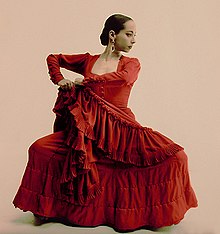Flamenco
From Wikipedia, the free encyclopedia
For other uses, see Flamenco (disambiguation).
| Flamenco | |
|---|---|

Flamenco dancer with traditional dress
| |
| Stylistic origins | |
| Cultural origins | |
| Typical instruments | |
| Subgenres | |
| New Flamenco (flamenco nuevo) | |
| Fusion genres | |
| Flamenco chill (with downtempo) | |
| Other topics | |
Flamenco (Spanish pronunciation: [flaˈmeŋko]) is an artform native to the Spanish regions of Andalusia, Extremadura and Murcia. It includes cante (singing), toque (guitar playing), baile (dance), jaleo (vocalizations), palmas (handclapping) and pitos (finger snapping).[1]
The oldest record of flamenco dates to 1774.[2] The genre originated in the music and dance styles of Andalusia.[3] Flamenco has been influenced by and become associated with the Romani people in Spain, however, unlike Romani music of northern Spain or eastern Europe, its origin and style is distinctively Andalusian.[citation needed] [4]
In recent years, flamenco has become popular all over the world and is taught in many non-Hispanic countries, especially United States and Japan. In Japan, there are more flamenco academies than there are in Spain.[5][6] On November 16, 2010, UNESCOdeclared flamenco one of the Masterpieces of the Oral and Intangible Heritage of Humanity.[7]
**Source: WikiPedia
To watch REAL performances of FLAMENCO just go to the nearest ''TABLAO'', you will love where you see!
No hay comentarios:
Publicar un comentario